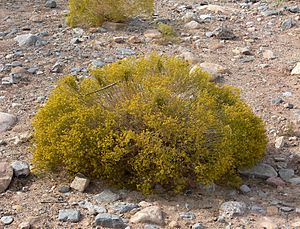Sticky snakeweed facts for kids
Quick facts for kids Sticky snakeweed |
|
|---|---|
 |
|
| Scientific classification | |
| Genus: |
Gutierrezia
|
| Species: |
microcephala
|
| Synonyms | |
|
Synonymy
Brachyris microcephala DC.
Gutierrezia euthamiae var. microcephala (DC.) A.Gray Gutierrezia glomerella Greene Gutierrezia lucida (Greene) Greene Gutierrezia microphylla E. Durand & Hilg. Gutierrezia sarothrae var. microcephala (DC.) L.D.Benson Xanthocephalum lucidum Greene Xanthocephalum microcephalum (DC.) Shinners |
|
Gutierrezia microcephala is a type of flowering plant. It belongs to the Asteraceae family, which includes daisies and sunflowers. People call it by many names, like sticky snakeweed or threadleaf snakeweed. This plant is a small subshrub, which means it's a bit like a bush but smaller. It grows naturally in the southwestern United States and northern Mexico. You can find it in dry grasslands and sandy dunes. If animals eat too much of it, it can be harmful to them. This is because it has natural chemicals called saponins and high levels of selenium.
Plant Description
Gutierrezia microcephala is a small, resinous plant that grows in the desert. It is a perennial, meaning it lives for more than two years. It usually grows about 20 to 60 centimeters (8 to 24 inches) tall. The plant is often very bushy and round. Its new branches are green or yellow. Older parts of the plant become brown and woody.
The leaves are long and thin, like threads. They are about 1 to 4 centimeters (0.4 to 1.6 inches) long. They are also very narrow, only about 0.5 to 2 millimeters (0.02 to 0.08 inches) wide. Both the leaves and the stems help the plant make its own food. This process is called photosynthesis. This plant is very good at it! G. microcephala usually blooms from July to October. But this can change depending on how much rain it gets.
When the plant blooms, small groups of flowers appear at the tips of its branches. These flower groups have 5 or 6 flowers each. The flower buds are bumpy and waxy yellow. They open into bright golden yellow flower heads. Each flower head has one or two tiny disc florets. These are about 2.2 to 3.3 millimeters (0.09 to 0.13 inches) wide. It also has one or two ray florets, which are about 2.1 to 3.5 millimeters (0.08 to 0.14 inches) wide.
The mature plants make many seeds. However, most of these seeds fall close to the parent plant. This is because the plant has a very small pappus. A pappus is like a tiny parachute that helps seeds fly in the wind. Since its pappus is small, the wind cannot carry its seeds very far.
Where It Grows
Gutierrezia microcephala is a plant native to North America. You can find it across the southwestern United States. This includes states like California, Texas, and Colorado. It also grows in northern Mexico, from Baja California to Tamaulipas.
This plant lives in many different ecoregions. These include dry grasslands, chaparral areas, and sandy dunes. It also grows in oak or oak-pine woodlands. G. microcephala prefers well-drained soils. These soils can be sandy, gravelly, or rocky. You often see it in creeks that sometimes dry up. It also grows on the slopes next to these creeks. It often grows best in shallow, rocky soil. This is where grasses do not grow very well.
Traditional Uses
Native American tribes used Gutierrezia microcephala for different purposes. The Cahuilla people used a liquid made from the plant as a gargle. They also put the plant in their mouths to help with toothaches.
The Hopi and Tewa tribes used the plant to help with tummy aches. They also used it to decorate prayer sticks. Sometimes, they used it when roasting sweet corn. The Navajo put a paste made from the plant on the backs and legs of horses. The reason for this is not fully known. The Zuni tribe soaked the flower heads in hot water to make a tea. They drank this tea to help them urinate more (as a diuretic). It was also used as a tonic and to make them sweat. The Zuni also used the plant to help them find water.
This plant is not very useful for most wildlife. Animals usually do not eat it. Livestock, like cows, only eat it if there is no other food available.
Toxicity
Gutierrezia microcephala can be harmful to livestock. This is especially true if the plant grows in sandy soil.
Management
Gutierrezia microcephala is a common and harmful plant on rangelands. It often shows that the land has been overgrazed or disturbed. Farmers and land managers try to control its growth.
Some chemicals, called picloram and triclopyr, can help control the plant. These chemicals can work for 5 to 7 years. But they need to be used with good grazing plans. Scientists have also studied using other living things to control it. This is called biological control. For example, a weevil from Argentina and a moth from Argentina can help. They both bore into the plant's roots.
Fire can also kill or badly damage G. microcephala. So, controlled burns are sometimes used to manage the plant. These burns must be done carefully. If there is enough moisture and other plants are not competing, G. microcephala might grow back. This means controlled burns do not always work perfectly. For a burn to be effective, there needs to be enough dry grass. The air should also be dry, with low relative humidity. The temperature should be warm, between 24 and 32 degrees Celsius (75 and 90 degrees Fahrenheit). A gentle breeze also helps.


